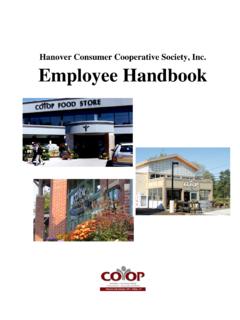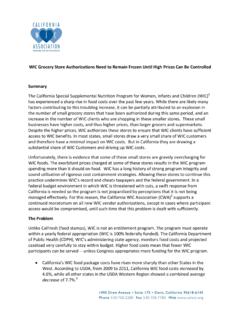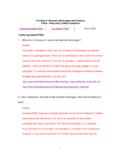Transcription of 2018Water Quality - Northern Kentucky Water District
1 2016 Water Quality REPORT #KY0590220 32017 Water Source InformationNorthern Kentucky Water District (NKWD) is the largest Water District and the third largest Water utility in the state of Kentucky serving approximately 300,000 people in Campbell and Kenton counties and portions of Boone, Grant and Pendleton counties. The Water District has a staff of individuals who are fully committed to excellence, working hard to uphold the District s mission to provide our customers a safe, clean and sufficient Water supply through a reliable system that meets all State and Federal standards, while delivering great value at a reasonable cost. NKWD operates three Water treatment plants.
2 They are Taylor Mill, Fort Thomas and Memorial Parkway. The Taylor Mill treatment plant s Water source is the Licking River while the Fort Thomas and Memorial Parkway treatment plants draw Water from the Ohio Water RegulationsNKWD s drinking Water meets all of the Environmental Protection Agency s (EPA) health standards. Our lab analysts gather Water samples from over 155 locations each month. This is more than federal and state regulations require, but we want to make sure that we have an accurate picture of the Water Quality . Please refer to the charts for more information regarding the Water Quality data for the calendar year of surface Water sources for NKWD are the Ohio and Licking rivers.
3 A source Water assessment has been completed on each. The following is a summary of the susceptibility analysis that is part of the source Water assessment. Several areas of concern are related to the extensive development of transportation infrastructure, the potential for spills, high degree of impervious cover and polluted runoff. Areas of row crops and urban and recreational grasses introduce the potential for herbicide, pesticide, and fertilizer use possible nonpoint source contaminants. Bridges, railroads, ports, waste handlers or generators, and Tier II hazardous chemical Water Quality REPORT2016 Fort Thomas Treatment Plant StorageOhio River Pump StationFort Thomas Treatment Plant Fort Thomas Treatment Plant StorageOhio River Pump StationFort Thomas Treatment Plant 2016 Water Quality REPORT * in the area introduce the potential for spills or leaks of hazardous materials into the source Water .
4 Landfills and permitted discharges are relatively high in number for a supply area. Other areas of concern include several segments of streams already assessed as having impairments, power lines right-of-way with potential herbicide use, and residential septic systems located throughout the watershed. Since the intakes are in urban areas, the threat of underground storage tanks leaking must also be taken into account. The entire source Water assessment report is available at the Northern Kentucky Area Development District , 22 Spiral Drive, Florence, KY 41042. Phone: 859-283-1885.* Tier II hazardous chemical users apply to any facility that is required under regulations by the Occupational Safety and Health Administration to prepare or have available a Safety Data Sheet for a hazardous chemical present at the Contaminants in the Water SupplyThe sources of drinking Water (both tap Water and bottled Water ) include rivers, lakes, streams, ponds, reservoirs, springs and wells.
5 As Water travels over the surface of the land or through the ground, it dissolves naturally-occurring minerals and, in some cases, radioactive material, and can pick up substances resulting from the presence of animals or from human Water , including bottled Water , may reasonably be expected to contain at least small amounts of some contaminants. The presence of contaminants does not necessarily indicate that Water poses a health risk. More information about contaminants and potential health effects can be obtained by calling the Environmental Protection Agency s Safe Drinking Water Hotline at order to ensure that tap Water is safe to drink, EPA prescribes regulations that limit the amount of certain contaminants in Water provided by public Water systems.
6 Food and Drug Administration regulations establish limits for contaminants in bottled Water which must provide the same protection for public health. Contaminants that may be present in source Water include: Microbial Contaminants. Examples include viruses and bacteria which may come from sewage treatment plants, septic systems, agricultural livestock operations and wildlife. Inorganic Contaminants. Examples include salts and metals, which can be naturally-occurring or result from urban stormwater runoff, industrial or domestic wastewater discharges, oil and gas production, mining or farming. Pesticides and Herbicides. These may come from a variety of sources such as agriculture, urban stormwater runoff and residential uses.
7 Organic Chemical Contaminants. These include synthetic and volatile organic chemicals, which are byproducts of industrial processes and petroleum production, and can also come from gas stations, urban stormwater runoff and septic systems. Radioactive Contaminants. These can be naturally-occurring or be the result of oil and gas production and mining Information about Your Drinking WaterNKWD received a notice of violation over the past year. Even though it was a monitoring error and not a Water Quality issue, we wanted you to know what happened and what we did to correct this are required to monitor your drinking Water for specific contaminants on a regular basis.
8 Results of regular monitoring are an indicator of whether or not our drinking Water meets health standards. During the compliance period of May 2016, we did not properly complete all monitoring for the routine bacteriological samples and therefore cannot be sure of the Quality of your drinking Water during that time. There is nothing you need to do at this time. Your Water meets all State and Federal standards. We are required to submit 150 bacteriological sample results to the Division of Water each month. In the month of May 2016, we were only able to report 148 valid sample results, because we did not perform the proper incubation time on 2 samples. The EPA method requires the samples to be incubated for 24 hours.
9 We mistakenly removed the 2 samples from the incubator 5 hours too soon. Although these samples did not show the presence of bacteria, they were invalid because the incubation time was too short. Compliance was met on all other monthly samples for the year. To prevent this situation from happening again, we have added more verification protocols to the monthly sample schedule, and we are collecting additional samples each month to assure that we have at least 150 sample results to report each month. Please share this information with all the other people who drink this Water , especially those who may not have received this notice directly (for example, people in apartments, nursing homes, schools and businesses).
10 You can do this by posting this report in a public place or distributing copies by hand or Water Quality REPORT people may be more vulnerable to contaminants in drinking Water than the general population. Immuno-compromised persons such as persons with cancer undergoing chemotherapy, persons who have undergone organ transplants, people with HIV/AIDS or other immune system disorders, some elderly, and infants can be particularly at risk for infections. These people should seek advice about drinking Water from their health care providers. EPA/CDC guidelines on appropriate means to lessen the risk of infection by Cryptosporidium and other microbial contaminants are available from the Safe Drinking Water Hotline at InformationSources of Infection by Cryptosporidium and other Microbial ContaminantsThere are many sources of Cryptosporidium (Crypto) and other microbial contaminants.








